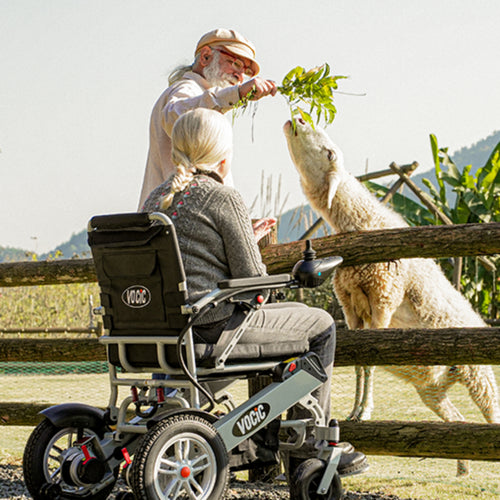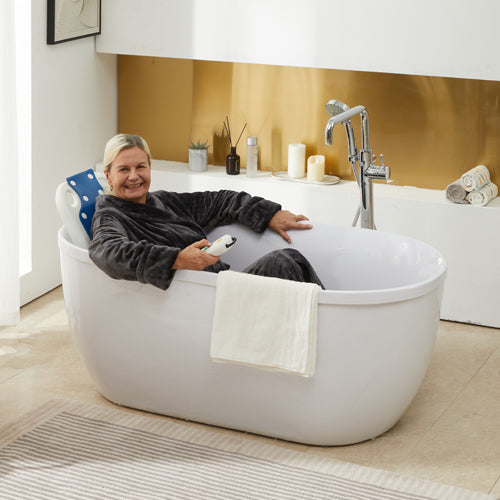You can carry a rollator with you. In the United States, airlines will provide free walkers and other mobility aids to passengers with limited mobility, making your travel more convenient. So how do you apply to carry a rollator on board? This article will show you what regulations and conveniences airlines provide for walkers, making your travel experience smoother and more comfortable.
What Kind of Walker Can I Take on a Plane?
Airlines provide disabled passengers with the convenience of carrying mobility aids (including walking frames) free of charge, so you can bring your mobility aids on board. So what are the different types of mobility aids you can bring on board? Let's find out:
-
Standard Walkers: Standard walkers are basic walkers without wheels. Therefore, they are easily folded and can be checked at the gate or stored in the overhead bin, provided the bin can be lowered.
-
Folding walkers: These walkers are the most convenient for air travel. This is because they can be easily folded and stored in the overhead bin or under the seat.
-
Rollator Walkers: Rollator Walkers have four wheels, brakes, and sometimes a seat. They offer optimal mobility and convenience. Therefore, it is a good choice for a walker for seniors because it provides greater support. In addition, many walkers now offer a foldable feature that you can fold up and check at the gate.
You can travel with any of the above mobility aids. However, you need to communicate with the airline and let them know that you will be traveling with a mobility aid. This will make your travel experience smoother.

What Are the Regulations for Travelling with Mobility Aids?
In the United States, airline policies for traveling with mobility aids (such as wheelchairs, walkers, and mobility scooters) ensure that passengers with limited mobility can travel safely and comfortably. Here are some of the main policies:
1. Right to Carry Mobility Aids and Pre-Flight Notification
In the United States, you have the right to carry mobility aids such as wheelchairs, walkers, and walking frames on board without paying any additional fees. Therefore, it is recommended that you notify the airline in advance, especially if you are carrying a larger or battery-powered mobility aid. This way the airline can make the necessary preparations to properly accommodate your device.
2. Boarding and Flight Arrangements
Your mobility aid can be checked in at the gate so that it can be safely stored in the aircraft's cargo hold and returned to you immediately upon arrival at your destination. If your mobility aid needs to be stored in the cabin, we will first check whether there is enough space. If not, we will place it in the cargo hold.
3. Boarding and Flight Arrangements
If you are carrying an electric wheelchair or other battery-powered mobility aid, the airline will follow strict packaging and handling regulations, especially regarding batteries. This is because lithium-ion batteries require special attention due to their potential fire risk. In addition, if your mobility aid is damaged during transportation, the airline will be responsible. You can find out about these liability terms and compensation procedures.
These help you better understand and comply with the policies for carrying mobility devices on board, ensuring a smoother and safer journey.

How Should You Prepare Your Rollator Before the Flight?
Being prepared for your flight will ensure a smooth journey. There are some procedures to be aware of beforehand. Here are some ways to prepare your mobility aid for your flight:
-
Check with Your Airline: Different airlines have different rules regarding rollator walkers. It’s best to check with your airline first to find out what their specific requirements are for walkers, such as size restrictions or whether you need to notify them in advance.
-
Give It a Once-Over: Take the time to check your rollator walkers. Make sure the brakes are working well, the wheels are secure, and there’s no visible wear. Clean it up to avoid getting flagged for dirt or debris during inspection.
-
Practice Folding: You’ll need to fold your rollator walkers at the gate before boarding. You’ll need to know how to fold it effectively and secure any loose parts or accessories so they don’t get lost or cause problems during transport.
-
Label It: Label your rollator walkers with your contact information and flight details – this way it won’t get misplaced and you’ll be able to find it more easily.
-
Get Ready for Security: Rollator walkers need to go through the security check and may have to go through an X-ray conveyor belt. Be prepared to fold your walker. If your walker is checked in and stored in the cargo hold, and you are unable to walk without it, you can ask the staff for help in advance.
-
Ask for Help When Boarding: Let the airline know when you book your ticket that you need help boarding. Airlines offer early boarding for passengers who need more time to settle in.
-
Check It at the Gate: When you arrive at the gate, let the agent know that you have a mobility aid. They will tag your mobility aid and prepare it for gate check so you can use it before boarding, and then give it to the agent to be stored in the hold.
Following these steps can help ensure your mobility aid is fully prepared for your flight, making your travel experience smoother and more enjoyable.
Conclusion
Airlines support the transportation of walkers or other mobility aids on board, so you can bring your rolled walker on board. Also, inform the airline in advance of the type of mobility aid you are bringing, as this will help them make the necessary preparations. By understanding and complying with the airline's policies and preparing accordingly, you can ensure a smooth and stress-free travel experience.
Related Reading: Can You Bring Electric Scooters on an Airplane?
FAQs
1. Do you have to pay to take a walker on a plane?
You can bring a mobility aid on board at no charge. The Air Carrier Access Act in the United States and similar legislation in other countries requires airlines to accommodate passengers with disabilities by allowing them to carry mobility aids such as walkers, rollators, and wheelchairs free of charge. This allows passengers with limited mobility to travel comfortably without incurring additional financial burdens. It is best to inform the airline in advance when you plan to travel with a mobility aid as this enables them to make the necessary arrangements to assist you throughout your journey.
2. Can I go through airport security with a walker?
You can use a mobility aid to go through airport security. Security personnel can assist passengers who use mobility devices such as walkers, rollators, and wheelchairs. As you approach the security checkpoint, your mobility aid will be inspected. At this time, you will be asked to remove any items such as bags or baskets from your mobility aid and may be required to go through an X-ray machine. If you are unable to pass through a metal detector, security personnel may manually check you while you are seated or provide other methods of screening. Make the entire security check smooth and courteous.
3. Can a walker (rollator) be taken to the cabin?
Rollators or mobility aids are generally allowed in the aircraft cabin, but this depends on the size of the mobility aid and the specific airline's policy. Currently, most airlines allow passengers to bring a mobility aid or mobility aid to the boarding gate. The mobility aid can be checked at the boarding gate, stored in the cargo hold during the flight, or if cabin space allows, it can be brought with you and stored in the cabin, such as in the overhead bin or designated area. It is recommended to contact the airline in advance to confirm their policy and arrange for cabin storage if needed to ensure a smooth and convenient travel experience.







